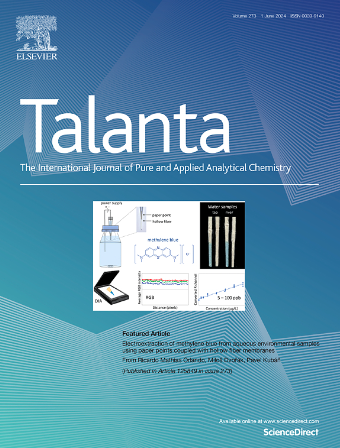Controllable construction of ZnSnO3 polyhedrons abundant in oxygen vacancies via cobalt doping and their acetone sensing performance
IF 5.6
1区 化学
Q1 CHEMISTRY, ANALYTICAL
引用次数: 0
Abstract
Increasing attentions have been paid to the development of ZnSnO3-based gas sensors for acetone detection, owing to their unique advantages of high electron mobility, low visible adsorption and excellent electrical conductivity. However, some intrinsic problems associated with low response remain to be satisfactorily resolved. Herein, cobalt (Co) doping was implemented in this work to simultaneously modulate the electronic structure and oxygen vacancy of ZnSnO3, a series of ZnSnO3 doped with varying quantities of Co ions were harvested through a hydrothermal method. The results reveal that the sensor, fabricated using ZnSnO3 with the incorporation of 10 mol% Co ions, manifests exceptional response (109) to 100 ppm acetone at 260 °C, accompanied by a speedy response/recover time (21/11 s). Furthermore, the gas device exhibits excellent comprehensive properties, including an ultra-low theoretical limit of detection (25 ppb), reliable long-term stability, as well as good anti-humidity performance. It is concluded by a series of characterization techniques that large BET surface area and abundant oxygen vacancies conduce to the significant enhancement in sensing performance. This study sheds light on fundamental understanding of how to tailor high-performance ZnSnO3-based sensing devices for toxic gas detection.

求助全文
约1分钟内获得全文
求助全文
来源期刊

Talanta
化学-分析化学
CiteScore
12.30
自引率
4.90%
发文量
861
审稿时长
29 days
期刊介绍:
Talanta provides a forum for the publication of original research papers, short communications, and critical reviews in all branches of pure and applied analytical chemistry. Papers are evaluated based on established guidelines, including the fundamental nature of the study, scientific novelty, substantial improvement or advantage over existing technology or methods, and demonstrated analytical applicability. Original research papers on fundamental studies, and on novel sensor and instrumentation developments, are encouraged. Novel or improved applications in areas such as clinical and biological chemistry, environmental analysis, geochemistry, materials science and engineering, and analytical platforms for omics development are welcome.
Analytical performance of methods should be determined, including interference and matrix effects, and methods should be validated by comparison with a standard method, or analysis of a certified reference material. Simple spiking recoveries may not be sufficient. The developed method should especially comprise information on selectivity, sensitivity, detection limits, accuracy, and reliability. However, applying official validation or robustness studies to a routine method or technique does not necessarily constitute novelty. Proper statistical treatment of the data should be provided. Relevant literature should be cited, including related publications by the authors, and authors should discuss how their proposed methodology compares with previously reported methods.
 求助内容:
求助内容: 应助结果提醒方式:
应助结果提醒方式:


